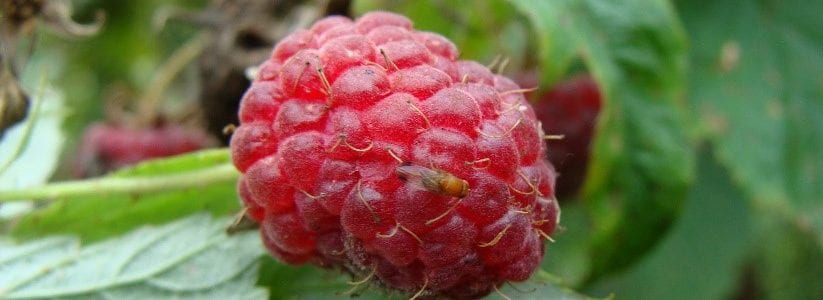Overall, still a quiet week for SWD trap captures in the Lake Ontario region's tart cherries. Although SWD was caught across the region, only 2 at most in the two traps set per orchard. Traps were checked Monday and Tuesday, June 15 and 16. Elizabeth Tee and Janet van Zoeren, Lake Ontario Fruit Program, and Grace Marshall and Juliet Carroll, NYS IPM Program, are participating in this study along with nine fruit growers.
In our 11 study orchards, SWD has been caught in 5 of the 6 “lake” blocks and in 3 of the 5 “inland” blocks. Specific trap catch results for this week were:
- Zero SWD in six orchards out of 11.
- First catch in one orchard = 1 female in edge trap.
- Recatch in three orchards = 1 male in edge trap; 2 females in edge trap; 1 male & 1 female in interior trap. Each orchard had one week with zero SWD between first catch and this week’s catch.
- Sustained catch in one orchard = 1 male in interior trap this week and 1 male in edge trap last week.
SWD populations were still low over the past week in tart cherry orchards. What can we credit with keeping SWD populations low, so far? Some possibilities include:
- Choosing insecticides that are also effective against SWD for other key cherry insect pests such as plum curculio or the Rhagoletis fruit flies (cherry fruit fly, black cherry fruit fly, European cherry fruit fly).
- The dry weather and low humidity.
- Lack of alternate fruit resources in the wild, due to freeze events.
- Slow progression of fruit development, due to the cold spring.
- Possibly the cold weather last week and cold nights lately.
Populations are low in berries, too, in western NY. This past week, SWD was only caught in one of the 12 berry sites in the Lake Ontario, Finger Lakes, and Central NY regions that we are monitoring.
Cherry fruit is starting to color.
Be watchful of your crop's development. Now is the time to plan your SWD management strategy so you have a good selection of rotational insecticides to protect your crop through to harvest.

For cherry fruit fly management (Rhagoletis spp.), choose insecticides that also have activity against SWD to keep the population down and protect your fruit from Rhagoletis fruit flies. Refer to the SWD Insecticide Quick Guide for tree fruit and grapes www.hort.cornell.edu/fruit/pdfs/swd/treefruit-grape-insecticides.pdf. Cross-reference this with the Cornell Pest Management Guidelines for Commercial Tree Fruit Production. Select insecticides wisely.
SWD can lay eggs in ripening cherries. If SWD has been caught in your orchard, ripening and ripe cherries will be at risk of SWD infestation. Pay close attention to preharvest intervals (PHI) and plan insecticide use so you have materials with lower PHI for use close to harvest. Rotate IRAC groups for resistance management. Drosophilids are known to develop insecticide resistance. Follow label directions. Be wise.
SWD management tactics
- Mowing – to reduce humidity and niches for SWD harborage and to increase sun penetration. Research has shown this works in tart cherry orchards in Michigan.
- Weed management – to reduce humidity, alternate fruiting hosts and harborage and to increase sun penetration.
- Pruning – to reduce humidity and to increase sun and spray penetration. Research has shown this works in tart cherry orchards in Michigan. Improve your pruning strategy this winter.
- Monitoring – to know if SWD is present when fruit is ripening. Don't spray unless SWD is caught. Some years your crop may not need a targeted program for SWD.
- Sanitation – to reduce reproduction harborage and overall SWD population. Important in diversified fruit farms.
- Those of you growing June strawberries, be mindful to renovate fields without delay (see blog, Renovate Strawberry Plantings Promptly, blogs.cornell.edu/swd1/2018/06/27/renovate-strawberry-plantings-promptly/) to avoid leaving cull fruit as a resource for SWD.
- Cold storage – to slow or kill any eggs and larvae in harvested fruit. Not applicable for a processing crop harvested into water tanks. SWD won't survive in water tanks; larvae may float to the surface or fruit may float higher because the infestation changes their buoyancy.

